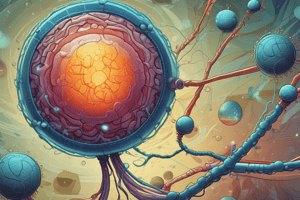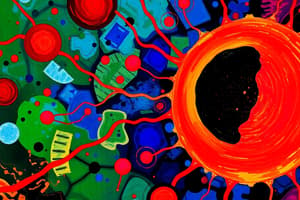Podcast
Questions and Answers
The majority of mutant p53 proteins are derived from nonsense mutations that lead to the production of truncated proteins.
The majority of mutant p53 proteins are derived from nonsense mutations that lead to the production of truncated proteins.
False (B)
XIAP is the least potent inhibitor of apoptosis.
XIAP is the least potent inhibitor of apoptosis.
False (B)
The half-life of mutant p53 proteins is decreased compared to wild-type p53 proteins.
The half-life of mutant p53 proteins is decreased compared to wild-type p53 proteins.
False (B)
IAPs are a group of proteins that regulate cell proliferation, differentiation, and signal transduction.
IAPs are a group of proteins that regulate cell proliferation, differentiation, and signal transduction.
XIAP is an autosomal inhibitor of apoptosis protein.
XIAP is an autosomal inhibitor of apoptosis protein.
P53 is a tumor suppressor protein that can induce apoptosis.
P53 is a tumor suppressor protein that can induce apoptosis.
The majority of mutant p53 proteins are unable to induce apoptosis.
The majority of mutant p53 proteins are unable to induce apoptosis.
XIAP is a poorly characterized inhibitor of apoptosis protein.
XIAP is a poorly characterized inhibitor of apoptosis protein.
IAPs are a group of proteins that regulate cell migration and adhesion.
IAPs are a group of proteins that regulate cell migration and adhesion.
Mutant p53 proteins have a shorter half-life compared to wild-type p53 proteins.
Mutant p53 proteins have a shorter half-life compared to wild-type p53 proteins.
Study Notes
Apoptosis
- A process of programmed cell death that occurs via an ordered sequence of events during growth and development of an organism.
- Morphological features:
- Cell shrinkage
- Karyolysis, pyknosis, and karyorrhexis
- Disrupted cell membrane
- Cytoplasm retained in apoptotic bodies
- Inflammation usually present
Apoptosis in Cancer
- Apoptosis prevents cancer by culling cells at risk of transformation.
- Apoptosis suppresses tumourigenesis in various ways, including:
- Induction of anoikis, a form of apoptosis that occurs when cells detach from the extracellular matrix (ECM).
- For cancer to initiate and progress, apoptosis must be inhibited at multiple stages, typically through the intrinsic pathway.
Anoikis
- A form of apoptosis that occurs when cells detach from the ECM.
- Activation of anoikis pathways:
- Lack of ECM contact or engagement with inappropriate ECM leads to decrease of anti-apoptotic pathways.
- Activation of death receptors and mitochondria.
- Intrinsic pathway induced by up-regulation of pro-apoptotic molecules.
- Extrinsic pathway activated through increased expression of Fas receptors.
p53
- A key player in cell cycle regulation, development, differentiation, gene amplification, DNA recombination, chromosomal segregation, and cellular senescence.
- p53 is called the "guardian of the genome".
- Defects in p53 have been linked to more than 50% of human cancers.
- p53 induces apoptosis by upregulating expression of Noxa and Puma BH3-only proteins in response to substantial levels of DNA breaks and other chromosomal abnormalities.
TP53 Mutations in Cancer
- Most mutations in TP53 detected in cancer cells are point mutations in the DNA-binding domain.
- 90% of mutant p53 proteins derive from missense mutations that allow the production of a full-length protein with a dramatically increased half-life.
Inhibitor of Apoptosis Proteins (IAPs)
- A group of structurally and functionally similar proteins that regulate apoptosis, cytokinesis, and signal transduction.
- X-chromosome linked, XIAP is the most potent inhibitor of apoptosis and the best-characterized IAP.
Studying That Suits You
Use AI to generate personalized quizzes and flashcards to suit your learning preferences.
Description
This quiz covers the FAS receptor activation and its role in triggering extrinsic apoptosis pathways, including type 1 pathway and caspase 7-dependent proteolysis.




